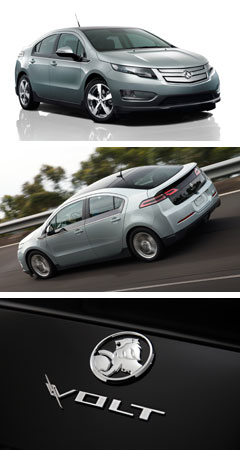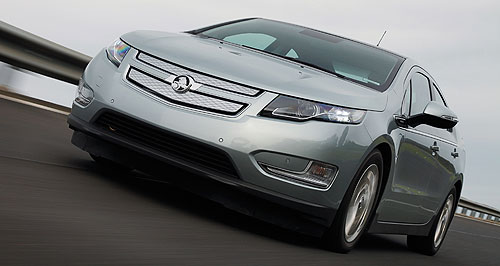Make / Model Search
Future models - Holden - VoltHolden goes public with 2012 VoltCountdown: The Holden Volt has arrived in Australia for early evaluation and testing ahead of its local launch one year from now. Plug-in Volt hits the road as Holden rips camouflage from range-extender trial cars15 Nov 2011 HOLDEN has started a one-year countdown to the launch of Australia’s first range-extender electric car, the Volt, by pulling the wraps off the first of three evaluation cars that are set to criss-cross the country to give the company a handle on the pioneering plug-in technology in Australian conditions. The initial car – a left-hand-drive Chevrolet from General Motors’ Detroit-Hamtramck plant in Michigan – arrived about a month ago, hitting the road with partial disguise to hide its identity. That camouflage has now been removed to reveal the final Holden ‘look’, complete with lion badges on the grille, wheel hubs and steering wheel, but otherwise near-identical to the Chevrolet model that has been on sale in North America since December 2010. Holden publicity photos of the front of the car appear to show a remnant of the fascia mounting for the Chevrolet ‘bow tie badge’ on either side of the circular Holden lion logo - which was not evident on images released in 2009. Production Holden Volts will not arrive in showrooms for another year, but Holden appears determined to build customer anticipation for the plug-in hatchback – along with its own ‘green’ credentials – by exposing the car that so far has no rivals in this country. The company showed the new arrival to employees at Holden’s Port Melbourne headquarters today, with chairman and managing director Mike Devereux describing it as a game-changer for Holden and the wider automotive industry in Australia.  “It is among the most technologically advanced cars on the road anywhere in the world and spearheads Holden’s push to become a leader in the field of technology and sustainable motoring,” he said. “The Volt will make driving more economical, more environmentally friendly and will fundamentally change the way Australia thinks about alternative transport solutions. “This is the start of something big for Holden and Australia.” In the US, the Volt hit a hurdle last week when it was revealed that one had caught fire after a side pole crash test by the official National Highway Traffic Safety Administration (NHTSA). But GM hit back by accusing NHTSA engineers of failing to follow GM safety protocols to “de-energise” the lithium-ion battery after the test (see separate story). Holden is expecting another two Volts to land in Australia before the end of this month to share the engineering and marketing load in the lead-up to the formal launch in the final quarter of 2012. Without the tax breaks and other incentives offered in the US, Europe and elsewhere, the Holden Volt price is expected to top $60,000 in Australia – almost double the price of the Chevrolet version in the US when full tax breaks are applied. Mr Devereux said last year that Holden did not expect to profit from the first-generation Volt, which he said would be expensive in Australia, but still expected the American-built car to sell “lots”. The Volt can be driven up to 60km on its lithium-ion batteries before a 63kW 1.4-litre petrol engine kicks in to generate electricity and extend the driving range to about 480km. The 16kWh batteries – which are guaranteed by GM for eight years or 160,000km – can be charged at home or work in about three hours on a 15-amp outlet, meaning most commuters will rarely need to fill up with petrol. Under new testing protocols in the US, the Environment Protection Agency (EPA) rates the fuel economy of the Volt at 93 miles per gallon (2.5 litres per 100km), compared with the benchmark Toyota Prius at 3.9L/100km. Holden said that, in the US, some Volt owners have recorded 2300km of travel without needing to refuel. Holden first showed a Volt in Australia at the 2009 Melbourne International Motor Show, releasing images of the car with Holden badges. The fresh Volt prototypes – all retaining left-hand drive – are destined for trips to Canberra and Sydney, where electric vehicle infrastructure is being introduced. Holden’s electrical engineering director Paul Gibson said these engineering validation exercises would ensure that the electric car charging infrastructure around the country supported the Volt and that the recharging process was as seamless as possible for customers. The Australian arm of GM is expected to import its production cars from the US, although production in other locations, such as China, has not been ruled out. Although most major motor companies have indicated they are likely to follow GM’s lead with a range-extender format, few are likely to match the Volt in the short term. So far, the choice of electrified cars has been restricted to full electric cars – such as the Mitsubishi i-MiEV – or pure hybrids like the Prius and Honda Insight. The Volt splits the difference, operating like an electric car in most daily driving but removing the “range anxiety” of battery-only electric cars. Toyota has signalled its intention to launch a plug-in range-extender version of the Prius in some markets, even trialling prototypes in Australia as part of EV fleet evaluations. The Japanese giant showed the Prius Plug-in Hybrid Electric Vehicle (PHEV) at the Frankfurt motor show in August, saying it would top the regular Prius range in Japan, Europe and North America in 2012. However, the vehicle remains under evaluation for Australia. The Prius PHEV can travel only 20km on electric charge from its 5.2kWh lithium-ion battery – compared with the Volt’s 60km on its 16kWh unit – but that is expected to give Toyota a cost advantage over the GM unit, which is also sold under Opel and Vauxhall badges as the Ampera.  Read more14th of November 2011  Volt fire probe raises GM hacklesCrash testers did not discharge battery on Chev Volt that went up in smoke, says GM9th of March 2011  Chevrolet Volt to go on sale in EuropeEuropean Volt price of €41,950 points to Oz price of $65k+All future models Alfa Romeo Alfa Romeo Abarth Abarth Alpine Alpine Alpina Alpina Audi Audi Aston Martin Aston Martin BMW BMW Bentley Bentley Chery Chery Brabham Brabham Chrysler Chrysler Chevrolet Chevrolet Cupra Cupra Citroen Citroen DS DS Dodge Dodge Fiat Fiat Ferrari Ferrari Foton Foton Ford Ford Great Wall Great Wall FPV FPV Haval Haval GWM GWM Honda Honda Holden Holden Hummer Hummer HSV HSV Infiniti Infiniti Hyundai Hyundai Jaguar Jaguar Isuzu Isuzu Kia Kia Jeep Jeep Land Rover Land Rover Lamborghini Lamborghini Lexus Lexus LDV LDV Mahindra Mahindra Lotus Lotus Mazda Mazda Maserati Maserati Mercedes-AMG Mercedes-AMG McLaren McLaren MG MG Mercedes-Benz Mercedes-Benz Mitsubishi Mitsubishi Mini Mini Opel Opel Nissan Nissan Peugeot Peugeot Pagani Pagani Proton Proton Porsche Porsche Renault Renault Ram Ram Rover Rover Rolls-Royce Rolls-Royce Skoda Skoda Saab Saab SsangYong SsangYong Smart Smart Suzuki Suzuki Subaru Subaru Toyota Toyota Tesla Tesla Volvo VolvoMotor industry news |
Click to shareHolden modelsResearch Holden All future models Alfa Romeo Alfa Romeo Abarth Abarth Alpine Alpine Alpina Alpina Audi Audi Aston Martin Aston Martin BMW BMW Bentley Bentley Chery Chery Brabham Brabham Chrysler Chrysler Chevrolet Chevrolet Cupra Cupra Citroen Citroen DS DS Dodge Dodge Fiat Fiat Ferrari Ferrari Foton Foton Ford Ford Great Wall Great Wall FPV FPV Haval Haval GWM GWM Honda Honda Holden Holden Hummer Hummer HSV HSV Infiniti Infiniti Hyundai Hyundai Jaguar Jaguar Isuzu Isuzu Kia Kia Jeep Jeep Land Rover Land Rover Lamborghini Lamborghini Lexus Lexus LDV LDV Mahindra Mahindra Lotus Lotus Mazda Mazda Maserati Maserati Mercedes-AMG Mercedes-AMG McLaren McLaren MG MG Mercedes-Benz Mercedes-Benz Mitsubishi Mitsubishi Mini Mini Opel Opel Nissan Nissan Peugeot Peugeot Pagani Pagani Proton Proton Porsche Porsche Renault Renault Ram Ram Rover Rover Rolls-Royce Rolls-Royce Skoda Skoda Saab Saab SsangYong SsangYong Smart Smart Suzuki Suzuki Subaru Subaru Toyota Toyota Tesla Tesla Volvo VolvoMotor industry news |











Facebook Twitter Instagram